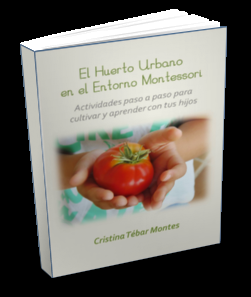(scroll down for English)
Aprender a observar va a ser nuestro RetoMontessori de Mayo, si te animas a unirte para trabajar este tema más a fondo te espero el viernes 28 de Abril a las 19:00 (hora de Madrid) en el webinar, puedes unirte aquí (tendrás acceso a la grabación por si no puedes asitir en directo).
Por si no sabes en qué consiste RetoMontessori te cuento: Cada mes (normalmente el último martes del mes), publico un post sobre un tema de filosofía Montessori o relacionado con la pedagogía Montessori, que será el tema que trabajaremos durante ese mes en RetoMontessori. Este post está en el blog a disposición de todo el mundo.
Tres días después del post, es decir, el viernes de esa misma semana, expongo el tema con más detalle en un webinar y los asistentes pueden participar planteando preguntas, compartiendo sus ideas, debatiendo, etc, algo que resulta muy interesante y enriquecedor! Para asistir a estos webinars mensuales es necesario unirse a RetoMontessori, aquí te explico cómo hacerlo.
No quiero enrollarme más sobre el funcionamiento de RetoMontessori para no extenderme mucho, pero si tienes cualquier duda ya sabes que puedes dejarme un comentario al final de este post o contactarme por email.
Después de esta intro, vamos al tema:

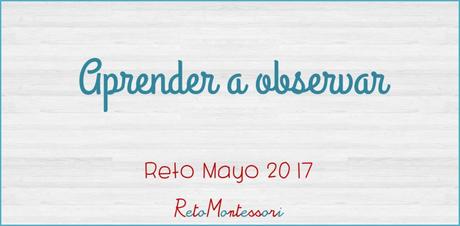
En Montessori hablamos mucho de lo importante que es observar, el ambiente en general y su funcionamiento, pero especialmente a cada niño en particular, y eso es en lo que nos vamos a centrar este mes en RetoMontessori.
Observar no es lo mismo que mirar, se trata de poner nuestra atención de verdad en lo que el niño está haciendo en ese momento, cómo lo está haciendo, de qué manera se relaciona con el entorno, qué cosas atraen su atención y cualquier otro detalle que nos resulte interesante para conocer mejor al niño.
En la formación para ser guía Montessori se realizan ejercicios como el que os voy a proponer para entrenar la capacidad de observación, y personalmente creo que todos los padres y madres también deberíamos hacerlos. Si somos capaces de observar a nuestros hijos, observarles de verdad, conseguiremos identificar sus necesidades, sus intereses, sus talentos y los obstáculos con los que se están encontrando para su desarrollo, y con esa valiosísima información seremos más capaces de satisfacer esas necesidades, apoyar esos intereses y eliminar o reducir esos obstáculos.
Ejercicio práctico: "Aprender a observar"
- En un momento en que dispongas de al menos 15 minutos y que tu hijo/a no esté pendiente de ti, dedícate a observarle, si quieres puedes tener a mano una libreta y bolígrafo para anotar aquello que te resulte interesante.
- Durante esos 15 (o más) minutos no hagas otra cosa que observar a tu hijo, poniendo toda tu atención, sin juzgar, sin intervenir, sin ponerte a pensar en eso que te ronda la cabeza, sin mirar el móvil, sin distraerte... Es prácticamente un ejercicio de mindfulness.
- Cosas que puedes observar y anotar: Su manera de moverse por el espacio, su forma de relacionarse con otras personas, cómo va cambiando su nivel de concentración, cómo reacciona cuando encuentra un obstáculo...
Puede parecer que observar es algo que todos podemos hacer, pero te aseguro que cuando hagas este ejercicio te darás cuenta de que es una habilidad que en general tenemos muy desentrenada. Tal vez en esos 15 minutos tu hijo haga algo maravilloso y te resulte fácil continuar observándole sin distraerte, o tal vez pases 15 minutos viendo a tu hijo hacer una tarea que para ti resulta absolutamente tediosa.
Observar requiere paciencia, una cualidad que en estos tiempos de prisas e inmediatez empieza a brillar por su ausencia...
En el webinar del viernes 28 de Abril hablaremos de esto con más detalle y como siempre, tendremos una ronda de preguntas para resolver dudas. Si quieres asistir y tener acceso a la grabación, puedes unirte ahora a RetoMontessori, te espero! 😉
¿Te ha gustado? ¡Compártelo! 🙂

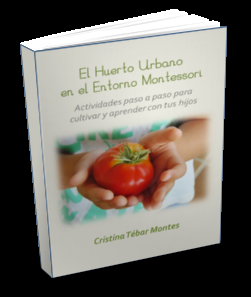

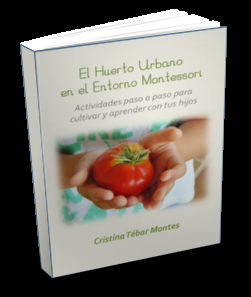

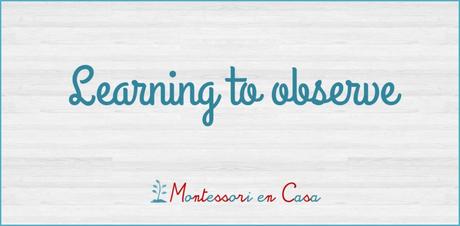
In Montessori we talk a lot about how important it is to observe, the environment in general and how it works, but especially every child, and that is what we are going to focus on today.
Observing is not the same as looking, it is about really focusing our attention on what the child is doing at that moment, how she is doing it, how she relates to the environment, what things attract her attention and any other details that we find interesting to know the child better.
In training to be a Montessori guide there are exercises to train the capacity of observation, and I personally believe that all parents should also do them. If we are able to observe our children, really observe them, we will identify their needs, their interests, their talents and the obstacles they are finding for their development, and with that invaluable information we can address those interests and eliminate or reduce those obstacles.
Practical exercise: "Learning to observe"
- At a time when you have at less 15 minutes and your child is not aware of you, take the time to observe him, if you want you can have a pen and notebook at hand to write down whatever you find interesting.
- Observe during the 15 minutes without doing anything else, focusing your full attention, without judging, without intervening, without thinking about what goes around your head, without looking at the cell phone, without getting distracted... It is practically a mindfulness exercise.
- Things you can observe and note: Your child's way of moving through space, her way of relating to other people, how her concentration level is changing, how she reacts when encountering an obstacle...
It may seem that observing is something that everyone can do, but I'm sure that after this exercise you will realize that it is a skill that in general is very untrained. Maybe in those 15 minutes you will see your child do something wonderful and make it easy to keep watching without distracting, or maybe you will spend 15 minutes watching your child do a task that is absolutely tedious for you.
Observing requires patience, a quality that in these times of hurry and immediacy seems to be fading away...
Did you like this post? Share it! 🙂

